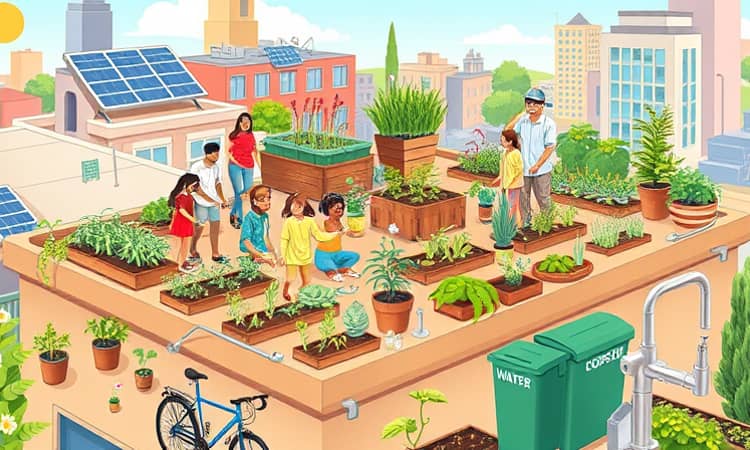Embracing a lifestyle that prioritizes the planet can feel overwhelming at first, but with small, manageable daily adjustments, anyone can start reducing their carbon footprint. This guide will lead you step by step, offering practical tips that fit into busy routines and help you become more environmentally conscious without sacrificing comfort.
Home Energy Tips
Your home is where you can make some of the most impactful changes to reduce your overall energy consumption. Simple habits and smart investments can translate into lower bills and a healthier planet.
- Unplug devices when not in use to avoid phantom power drain.
- Switch to energy-saving light bulbs and use natural light during the day.
- Turn off lights as you leave each room and pull the plug on idle electronics at night.
- Invest in a pressure cooker, which can cut cooking energy by up to 70% compared to conventional pots.
Waste Reduction Strategies
Adopting the reduce, reuse, recycle principle means prioritizing reduction first. This not only limits waste but also curbs unnecessary spending.
- Perform a waste audit: track what you throw away for one week to spot improvement areas.
- Focus on eliminating the “big four” disposable items: plastic bottles, bags, coffee cups, and straws.
- Opt for reusable cloths instead of paper towels and switch to digital bills.
- Use rechargeable batteries and matches rather than disposable options.
Sustainable Food Choices
What you eat can make a profound difference. By shifting your shopping and cooking habits, you not only lower greenhouse gas emissions but also support local economies and improve your health.
Buy locally produced food whenever possible to support nearby farmers and cut transport emissions. Joining a Community Supported Agriculture (CSA) program connects you directly with growers and guarantees fresh, seasonal produce. If space is limited, try container gardening or sprouting seeds on a windowsill—grow your own food at home with minimal effort.
Incorporate at least one plant-based meal per week. Even a single meatless day can reduce your carbon footprint significantly. Plan your meals to avoid food waste and start composting kitchen scraps. A compact indoor bin or small outdoor pile can transform peels and coffee grounds into valuable soil enrichment.
Sustainable Shopping Habits
Adopting a minimalist approach helps curb consumerism. Before purchasing, ask yourself if the item is essential. Only purchase what you truly need and consider second-hand or refurbished options for clothing, furniture, and electronics. Mend and repair broken items rather than discarding them, and donate or recycle what you no longer use. Gradually replace single-use products with eco-friendly alternatives, such as cloth shopping bags and glass storage containers.
Water Conservation and Transportation
Water is finite, and transport is a major source of emissions. Together, small steps in these areas generate significant benefits.
In the bathroom, turn off the faucet while brushing teeth and take shorter showers. Installing water-saving fixtures like low-flow showerheads and faucet aerators can cut usage by up to 30%. In the kitchen, capture cold water in a pitcher for drinking instead of letting it run while you wait for heat.
When it comes to getting around, choose active transport—walking, cycling, or scootering—whenever feasible. Public transit and carpooling reduce traffic and emissions. For necessary car trips, consider a fuel-efficient or hybrid vehicle. And if you can, aim to minimize air travel by planning longer stays or exploring local destinations.
Sustainable Home Products
Replacing everyday items with greener alternatives is an easy way to make your home more sustainable. Try these swaps:
- DIY cleaners made from vinegar, baking soda, and essential oils.
- Bamboo toothbrushes and bar soaps instead of bottled products.
- Reusable straws and compostable pet poop bags.
- Houseplants such as snake plants and spider plants to improve indoor air quality.
Room-by-Room Approach
Transform your home one space at a time. This method keeps progress manageable and prevents burnout.
Community Engagement
Lasting change often happens in groups. Share your journey, inspire others, and broaden your impact. Talk to friends and family about your new habits. Consider joining community gardens or groups, signing petitions for climate action, or hosting eco-friendly potlucks. Spreading awareness and collaborating with neighbors can create a ripple effect that extends your efforts far beyond your home.
Conclusion
Starting small and building momentum is the key to a sustainable lifestyle that lasts. By making intentional choices every day, you can shrink your environmental impact, save money, and feel empowered in your role as a steward of the planet. Remember, every positive change—no matter how minor it seems—adds up to something much bigger when we all contribute. Begin today, and watch your efforts grow into a lifelong commitment to a greener future.
References
- https://www.conservation.org/act/sustainable-living-tips
- https://www.cbs.de/en/blog/sustainable-living-tips-for-a-more-sustainable-lifestyle/
- https://isleacrefarms.com/sustainable-living-for-beginners/
- https://www.bonandberg.com/post/ultimate-guide-to-sustainable-living
- https://davidsuzuki.org/living-green/fifteen-top-tips-for-everyday-sustainable-living/
- https://ecobnb.com/blog/2021/02/sustainable-living-blog-writing/
- https://fulfilledlifestyleco.com/beginners-guide-to-sustainable-living/
- https://www.greenmatch.co.uk/blog/how-to-be-more-eco-friendly














